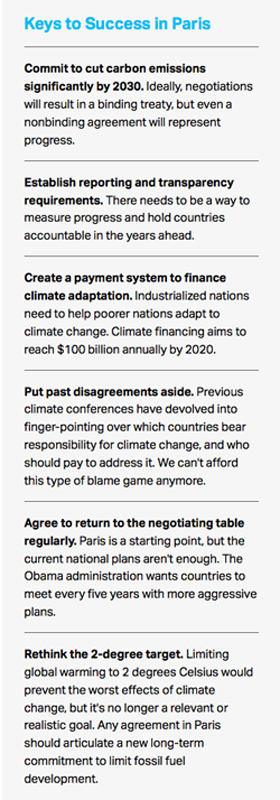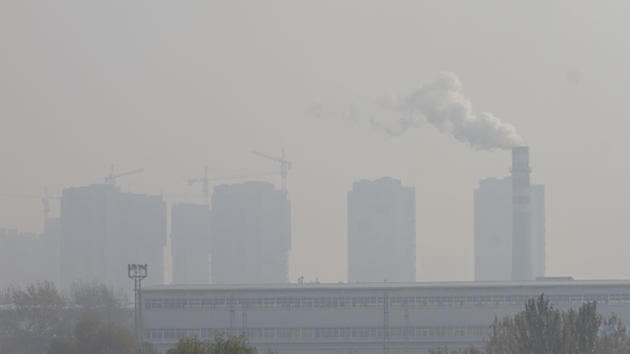
More than 300,000 computer-controlled mirrors gather light at the Ivanpah Solar Electric Generating System in Primm, NevadaChris Carlson/AP
This story originally appeared in the New Republic and is reproduced here as part of the Climate Desk collaboration.
Right now, we’re in a car, hanging on for dear life as we hurtle around a mountain bend. If we don’t hit the brakes soon, we’re going to lose control, crash through the guardrail, and careen into the abyss. We’ve been fully warned about the danger ahead, but now here we are, testing our fate.
Already, the effects of climate change are clear and significant. Last year was the hottest in recorded history, and it’s all but certain that 2015 will set a new record, according to the National Oceanic and Atmospheric Administration. Wildfires in the West this year have consumed a massive eight million acres of land and counting, while superstorms like Katrina and Sandy are becoming stronger and more frequent. But that’s just the beginning. By the end of the century, the planet will become unrecognizable. The western United States will face Dust Bowl-like conditions that will persist for more than 30 years. As the oceans rise, island nations like the Maldives could disappear completely, while millions of people in Miami, New York, and Bangladesh will be forced from their homes. Looking further out, over the next several hundred years, the melting ice caps could cause sea levels to surge up to 200 feet, high enough to sink a ten-story building.
These are not fantasies dreamed up by some Hollywood studio. They’re ripped from the pages of sober scientific journals and official reports. The Intergovernmental Panel on Climate Change, which operates under the auspices of the United Nations, foresees environmental impacts that are “severe, pervasive, and irreversible.” The World Bank has warned that humanity may not be able to adapt to this warmer world.
By certain measures, it’s already too late. Politicians, climatologists, and environmental activists have long rallied around 2 degrees Celsius of warming as a decisive point, after which we can no longer stave off disaster. Today, however, we’re already at 0.9 degrees of warming above preindustrial averages, and we’re on track to blow past 2 degrees by the middle of the century and well over 4 degrees by the end of it. At the rate we’re going, just limiting global warming to 2 degrees is a pipe dream.
That doesn’t mean the planet is doomed, however. We can still prevent the most devastating effects of climate change if we take action now. The 2-degree target isn’t a hard and fast cut-off, says NASA climate scientist Gavin Schmidt. Instead, it’s more like a speed limit. “The faster you’re going around that curve, the more dangerous it is going to be,” he told me. We may end up scraping the guardrail on our way around the mountain bend, but it’s still possible to keep the car on the road.
At a basic level, in order to ensure our survival, we need to end our reliance on fossil fuels as quickly as possible. Jennifer Morgan, global director of the climate program at the World Resources Institute, said that in order for the Paris talks to be counted as a success, they must at least agree on this central point: “There’s just one direction of emissions, and that is going down.” Charting that course is what world leaders must do this fall when they meet for two weeks in Paris for the twenty-first United Nations Framework Convention on Climate Change.
Past international attempts have failed to reach a consensus on even that basic point. But we know that if we do nothing, we risk calamity for the most vulnerable people in the world. And we know with the same clarity what needs to happen in Paris in order for the world to avert the worst-possible scenarios of global warming.
Paris is not shaping up to be a repeat of Kyoto in 1997 or Copenhagen in 2009 or other conferences that resulted in little more than artificial promises. The long history of failed efforts to address climate change on the international stage has left many environmentalists disillusioned and skeptical that progress can be made. For decades we’ve waited for some grand wake-up call. But there is reason to believe that 2015 will represent a real turning point, the moment we finally got serious about saving the planet.

To succeed, the Paris conference must produce an agreement in which industrialized nations pledge to cut carbon emissions significantly by 2030. It should also lay out a longer-term roadmap to midcentury, when developing nations will hopefully make similar leaps. Given current political realities, any agreement forged in Paris won’t be a binding treaty. Yet even a nonbinding agreement will be a positive outcome if it requires nations to be transparent about their progress and sets up a system for financing the costs associated with adapting to climate change.
More importantly, though, Paris must be viewed as the beginning of a long process of reviews and revisions. Countries should agree to return to the table every few years with new plans that are more ambitious than whatever they commit to in Paris this fall. This isn’t an excuse to kick the can down the road, as we have done for far too long, but an acknowledgment that climate change can be solved only in a series of steps, not one fell swoop. Paris is that starting point.
Indeed, officials acknowledge that meeting the 2-degree limit is all but impossible. The proposals currently on the table “do not take us to 2 degrees,” the U.N.’s Christiana Figueres, the chair of the Paris talks, told The New Yorker in August. Environmental groups have expressed their displeasure that Paris is already, by that measure, an empty promise. Ben Schreiber, climate and energy program director of the U.S. branch of Friends of the Earth, criticized world leaders for failing to take the steps necessary to reach the 2-degree goal. Paris “is not taking us down a pathway for a just climate agreement,” he said.
But a new consensus is emerging that limiting warming to 2 degrees in a single conference shouldn’t be the only criteria for success. Robert Stavins, director of the Harvard Environmental Economics Program, sees 2 degrees as an aspirational target that’s “really not achievable.” If we remain wedded to that goal, he said, we risk falling into despair and apathy. “The most ambitious target that can be isn’t necessarily the best one that can be done. It is the most realistic one,” Stavins said.
“Paris is incredibly important in that it shaves off 1 degree Celsius,” said Andrew Jones, the co-director of Climate Interactive, an MIT-affiliated climate policy group. “It is a much better world, and it sets off the framework for ratcheting up ambitions in the future.”
In the run-up to the talks, countries have drafted individual proposals—formally called Intended Nationally Determined Contributions (INDCs)—to make progress toward that goal. The United States has offered to cut greenhouse gas emissions 26 to 28 percent from 2005 levels by 2025. The European Union has set a target of a 40 percent cut from 1990 levels by 2030. Canada has proposed a 30 percent cut from 2005 levels by 2030.
For the first time, too, developing nations have offered plans as well—that they are finally factoring pollution into their economic thinking is monumental progress compared to previous climate conferences. China has zeroed in on 2030 as roughly the year by which it hopes to achieve peak levels of carbon dioxide emissions. India offered its plan in October, the last major economy to do so. As expected, India’s plan is a mixed proposal that gives no deadline for when its emissions will come down. Instead, India wants rapid economic growth at a lower intensity of emissions, combined with aggressive renewable development.
These proposals are both the summit’s brightest point of optimism as well as a looming disappointment. Together, the INDCs would slow the growth of 90 percent of the world’s carbon emissions. These plans aren’t ambitious enough to stave off the worst effects of climate change, though, and many of the richest nations, including EU countries, the United States, and Canada, could still do more. According to an analysis in September by researchers at Climate Interactive, taken together the proposals would put the planet on track for 3.5 degrees of warming, assuming countries take no further action after their pledges run through 2030. That’s better than the 4 degrees or more that we’re currently facing, but still too high for comfort. “If action stopped after the pledge period, if all we followed were the INDCs, we would create a world that we would not be able to adapt to,” Jones said. Climate Action Tracker, a Germany-based group that has assessed INDCs, is more optimistic that countries will continue to cut emissions post-2030. By that hypothesis, we’re still only on track to limit warming to around 2.7 degrees. Still, all progress is good progress.
The United States is keenly aware that the focus on establishing ambitious, binding targets for cutting emissions has doomed previous climate negotiations, and it has been working to ensure that expectations for a quick fix in Paris do not get out of hand. “We will not know in 2015,” whether Paris is a success, U.S. climate envoy Todd Stern told The Guardian earlier this year. “The rush to judgment, that this does not do enough, is not the way to think about this.”
Instead, the White House’s position is that success cannot be measured in degrees or percentages, but rather in momentum—a shared understanding that the situation is serious and that progress must be made. “I’m less concerned about the precise number, because let’s stipulate right now, whatever various country targets are, it’s still going to fall short of what the science requires. So a percent here ?or a percent there coming from various countries is not going to be a deal-breaker,” President Barack Obama told Rolling Stone this summer. “The key for Paris is just to make sure that everybody is locked in, saying, ‘We’re going to do this.'”
But momentum means more than speeches and modest national pledges tied up in a bow. How far countries go in creating momentum rather than following existing trends will be what separates Paris from the conferences that came before it.
In fact, the United States sees Paris as just the first of many such meetings in the years ahead. The Obama administration wants to come away from Paris with an agreement that countries will reconvene every five years with ever-more ambitious plans to cut carbon emissions. Countries that have mediocre proposals today could turn them into stronger plans in a few years, especially if economic circumstances change faster than expected. China, for example, may find that by 2020, the rising cost of coal and cheapening clean energy technologies mean it can start limiting its emissions earlier than 2030, as currently anticipated, especially if its newly devised national cap-and-trade plan is effective. In this view, Paris will establish a floor for emission cuts upon which countries can build.
In many ways, too, the most important goal at the Paris conference is not the targets for emission cuts themselves, but rather a consensus on some of the key questions that have plagued these conferences from the beginning: Who bears responsibility for climate change, and who will ultimately shoulder the cost of addressing it? Success at the conference will depend on how thoroughly these questions are addressed.
A lack of agreement on these points has doomed previous climate talks. Rapidly growing countries, like China, India, and Brazil, have been loath to curb their own emissions, since the United States and Europe are far and away the largest historical polluters. And industrialized nations, in turn, have used the reluctance of developing nations to disavow that development path as an excuse not to act.
However, the easiest and cheapest ways to cut greenhouse gas emissions actually start with developing nations, where there is more opportunity to improve energy efficiency and land use and to scale up clean energy. Since these countries lack the type of fossil fuel-centered infrastructure that is common in the West, millions can gain access to electricity through clean energy instead. India is doing just that, for example, by pledging to add solar panels to millions of rooftops, a departure from the centralized power grid in the United States. Prime Minister Narendra Modi wants to expand solar capacity fivefold to 100 gigawatts by 2022.

India needs help to fund the project, which is expected to reach $100 billion. “That would be transformational in India, but it’s clear they can’t do it on their own,” said Alden Meyer, the director of strategy and policy at the Union of Concerned Scientists, who has followed international climate talks since the early ’90s. Because the entire world will benefit from cutting carbon emissions and supporting clean energy, it’s fair to expect the entire world to share the cost of such programs.
One of the few successes of the last major climate change conference in Copenhagen in 2009 was the call to create the Green Climate Fund to help developing nations adapt to climate change. So far, countries have pledged just over $10 billion, which is on track to be distributed this fall. But the goal is to reach $100 billion annually by 2020. Meyer counts these financial commitments as necessary to help nations like India “leapfrog over the centralized power grid” that’s defined economic growth for industrialized nations. Paris will need to establish a framework for these payments and a system to ensure the money isn’t wasted.
Even with these recalibrated expectations, however, the Paris talks could still fall apart. Though negotiators have been meeting throughout the year to hammer out differences before they get to Paris, progress has been slow.
Most of the potential disagreements in Paris are likely to fall along familiar fault lines: whether targets for cutting emissions should be binding, and which countries should bear the most responsibility. The EU, for example, has pushed for a treaty with legally binding targets. But for other nations, including the United States and India, such a requirement is a nonstarter. Their reasons differ: For the United States, the Obama administration is politically constrained by a Republican-controlled Senate that will not ratify any such treaty, while India is afraid to harm a growing economy. In theory, an agreement could have some legally binding element that requires countries to implement or ratchet up future ambitions, but there’s little consensus on what exactly should meet strict expectations.
So if there will be any teeth to the agreement at all, it’s likely to be focused on reporting requirements and transparency, so that countries are required to show that they are implementing their own proposals. Even in a largely nonbinding symbolic document, there still needs to be some way to measure progress so countries follow through on their pledges.
Finally, there’s the issue of whether and how the agreement expresses a long-term goal to limit fossil fuel development—a rethinking of the 2-degree target. That would put into words a new target that gets nations thinking more about the medium term, an agreed-upon goal like decarbonizing the economy, phasing out fossil fuels, or achieving a certain level of cuts globally by midcentury. The hope is that assigning a deadline will strengthen countries’ commitments to limit out-of-control warming, since the energy infrastructure built in the next few years can lock in emissions for decades to come.
With this much left unresolved, the only outcome that is certain is that there will be the usual cramming sessions, running up to the last hour in the middle of the night, before world leaders head home with an agreement in hand—or nothing at all.
But the Obama administration has learned from the mistakes of previous climate change conferences and laid the groundwork for Paris well. Obama has traveled the country rallying the American people to support climate action, including the first presidential trip to the Alaskan Arctic? in August. “This is not simply a danger to be avoided; this is an opportunity to be seized,” he told a conference of Arctic nations in Anchorage. “On this issue, of all issues, there is such a thing as being too late.”
And he’s backed up his rhetoric with action. In his second term, the president has established the first-ever limits on U.S. coal pollution in the power sector. He’s offered $3 billion in climate financing to poorer nations (though the money could be tied up indefinitely by an uncooperative Congress). And he’s forged a series of bilateral climate agreements with China, India, Brazil, and Mexico that have smoothed the road to Paris. His critics charge he could have done more, but this is more progress than any other U.S. president has made.
Obama may not be backed by Congress, but he’s backed by public opinion. Polls show that a majority of Americans accept climate change as a reality and are concerned about it. In a Pew poll this summer, 69 percent of Americans identified climate change as a “serious” problem, up from 63 percent in 2010. Gallup polling puts concern about climate change somewhat lower, but still hovering at 55 percent. Obama’s efforts may get another boost from Catholics who followed Pope Francis’s first visit to the United States this fall. The Pope has used the weight of the church to rally the world’s one billion Catholics behind environmental justice.
The U.S.-China deal in particular, first announced in the fall of 2014 and strengthened in September of this year, was a breakout moment in the run-up to the Paris talks, since it signaled to the world that the longtime opponents at previous conferences were finally ready and able to make a deal.
Jennifer Morgan of the World Resources Institute was with the South African negotiating delegation when news of the U.S-China deal broke. She described the sense of relief at seeing that both countries were “in” for cooperation. The reaction in the room, she said, was, “Oh, they’re serious.”
The most optimistic feature of Paris is that negotiations no longer exist in a vacuum. Indeed, the economic landscape has shifted since the 2009 Copenhagen conference, when the hope of addressing climate change appeared to be lost. Global investment in clean energy has jumped from $45 billion to $270 billion in the last ten years and will grow as more and more countries institute a price on carbon, as dozens already have. Clean energy still has a long way to go—the United States currently gets just 13 percent of its electricity from renewable sources, including hydropower—but the pace of change is startling.
And solar is the brightest story. The price of solar energy has dropped 78 percent since Obama took office. Even without federal policies that offer generous tax breaks for clean energy, the United States is poised for a revolution “when solar becomes that technology of choice,” explained Bloomberg New Energy Finance analyst William Nelson. The price of wind energy has also dropped 58 percent. The switch to renewables is having a significant impact. In 2014, the global economy grew by 3 percent, but world emissions remained flat—exactly the sort of trend that needs to continue if the world is to keep growing without spinning into a death spiral.
Meanwhile, the coal industry is facing a steady stream of bad news. The symbolic movement to divest from fossil fuel assets hit $2.6 trillion in pledges this year, 50 times more than where it was a year ago, exceeding even activists’ expectations. The boom in natural gas development has eaten into coal’s prominence as a power source, and cheap clean energy and federal regulations have also contributed to the largest wave of closed-down coal plants the United States has ever seen. Global leaders don’t have to convince the world that renewable energy is the future. They just need to hasten that future along.
If they succeed, the world will look dramatically different even in our own lifetimes. Billions of young trees will help take carbon out of the air, as reforestation efforts make headway. The sun could be our single largest energy provider, up from just 0.5 percent globally today. Sunny cities will have solar panels lining rooftops as far as the eye can see. We won’t be debating whether to build new pipelines to carry oil from coast to coast, but where to locate the next wind farm. In the United States alone, the oil rigs that dot the landscape in Texas and North Dakota could give way to sprawling fields of turbines. If that happens, we could look back at the Paris talks as the moment that truly made the future possible.














